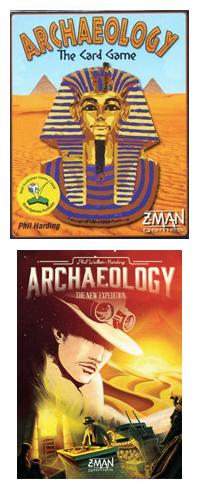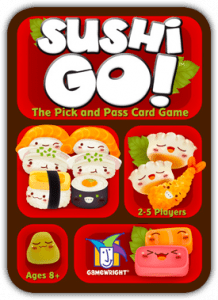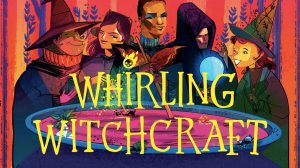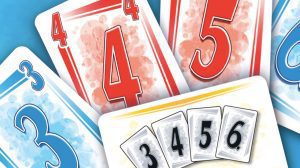Join Meeple Mountain as we welcome Phil Walker-Harding, the designer of the Spiel des Jahres nominee Imhotep, the smash hit Sushi-Go!, Cacao, and the newly released game Bärenpark to the interview table. Phil’s self-stated goal is
to design board and card games that are accessible, intuitive, engaging and capable of creating social spaces for diverse groups of people to connect and have fun.
Welcome Phil!
What games are you playing these days?
I’ve been playing quite a lot of social deduction games lately like One Night Ultimate Werewolf and Don’t Mess with Cthulhu. This is a genre I have really enjoyed exploring. I’ve also been having a great time with Kingdomino, especially the 2 player variant. I should also mention the new iOS version of Race for the Galaxy. It has been one of my favourite games for a long time, so it’s a real treat to be able to have a quick game of it any time!
The oldest game of yours that I could find was Archaeology. How do you think your designs have evolved since then?
 Yes, that was my first self-published design back in 2007! I think a huge thing I have learnt is to make sure I have a clear and simple vision for each of my designs. Knowing exactly what I’m trying to create and then honing the entire game to provide that experience is something really important to my process these days. I have also become stronger at diagnosing and fixing problems in designs, but this is something that largely comes from lots of practice and lots of playtesting!
Yes, that was my first self-published design back in 2007! I think a huge thing I have learnt is to make sure I have a clear and simple vision for each of my designs. Knowing exactly what I’m trying to create and then honing the entire game to provide that experience is something really important to my process these days. I have also become stronger at diagnosing and fixing problems in designs, but this is something that largely comes from lots of practice and lots of playtesting!
AM: The new version of Archaeology looks amazing by the way.
Z-Man games reissued Archaeology last year. If you could pick any of your other games to be redone and released with a new look, what game would it be, and why?
It would have to be Cannonball Colony, which I self-published in 2008. It’s a 2-4 player abstract that I am still quite fond of. Because I hand-made each copy, the original components were definitely nothing to write home about! I think a larger version of the game with really nice 3D bits would be much more fun to play. Actually, I recently streamlined the design a bit and made myself a fancy new prototype with Fimo clay! So it may see the light of day again in some form.
Sushi Go! was your first breakthrough game. To what do you attribute its success?

I think the ‘pick and pass’ drafting mechanism is inherently really fun and I did what I could to help the players experience it in it’s simplest form. I also tried to make the scoring simple enough for children to play but with enough tricky decisions that adults could find some fun in the game as well. The theme and cute art I’m sure also play a big part!
In a 2014 interview with Ryan Sanders you said “I am so often designing with particular components in mind”. I’m particularly interested in your “designer’s box”. What components most inspire you?
Well lately I have had a whole lot of Imhotep components around, particularly the large 15mm wooden cubes. These are a great component to play around with as you can really build things with them! Gluing a bunch of these cubes together into different shapes actually triggered an idea for a game I am working on now. I do have a couple of boxes of miscellaneous game bits, but it’s mostly just the usual stuff – cubes, dices, disks, pawns etc.
Ryan Sanders interviews Phil in 2014.
Your games appeal to such a wide range of the public: young, old, gamers, non-gamers. What do you think it is about your designs that resonates with people?
When I am designing, a main principle I have in mind is accessibility. That is, I want the widest range of people to be able to learn the game quickly and dive right into it. Because I am most interested in light to medium strategy games, most of my designs end up being about providing some satisfying strategic experience with the absolute minimum barriers to entry. I think this must be what clicks with players – the feeling that with very few rules they can be making clever decisions, devising plans and interacting in interesting ways. At least I hope that’s it!
Your games have some really distinctive components. For example the cubes in Imhotep, or the 2 pounds of cardboard in Barenpark. What trade-offs, if any, do you have to make with the publisher to include them?
Publishers are of course very concerned about the price point and size of the final product, so this factors into which components they choose. But so far I haven’t really had to push for any specific component choice too hard. I did say to Kosmos that having really big cubes in Imhotep was absolutely essential, because so much of the satisfaction of playing is seeing the structures being built on the table. Thankfully they understood that too!
AM: Lucky for us, the cubes are so great.
Do you as a designer ever focus on cost, or does that come purely from the publisher?
That’s the publisher’s job, however as a freelancer it is important when you pitch a game that it has components which fit within an appropriate price-point. Over time, I have developed a better understanding of this. Often I will know that I need to cut down on the size or number of components before it is worth pitching a certain game to a particular publisher.
Speaking of components, I want to ask about the insert for Cacao. It’s really well designed, but the ¼ inch gap between lid and components feels like a mistake. You or the publisher put out a really clever fix for it, but how did it happen to begin with?

I think some publishers don’t think too much about how a game will store on its side on someone’s shelf! It is actually a hard thing to get right because unpunched components take up so much more space inside the box. In the case of Cacao, the gap was there because that’s where the punchboard sat when the game was shipped. If it’s not possible to have everything sit flush against the box top, you need to compromise somewhere. Abacus came up with the idea for including a special insert with the Volcanoes promo which solves the problem, so that was cool!
AM: I picked up NMBR 9 from AbacusSpiele a few months ago. In my copy the lid was actually raised up about a ¼ inch inside the shrink wrap. After punching all of the pieces and recycling the cardboard the lid fit snugly!
What’s your personal favorite game mechanism?
I’d love to say something cool like deck building or worker placement, but actually I think it is set collection. Collecting sets of cards or some other resource is an element of so many games I like, and it often shows up in my own designs too. I think It taps into that real-world thrill that comes with trying to collect something over time. It’s why trading cards have always been so popular I suppose. Actually, most hobbies have some element of collecting which is interesting.
Can you name one game mechanism that you really like that you haven’t yet used in a design, and why haven’t you used it?
I think just about every designer has tried their hand at a deck building game. I’d love to make one but I have never succeeded in coming up with anything that feels unique enough to pursue. Still, every now and again I have another crack at it!
I read that you recently completed your Masters in Theology. Could you tell us a bit about that aspect of your life? Do you see that as a potential career? What impact, if any, does it have on your game designs?
I actually work part-time at my church where I look after a small non-traditional congregation, which is a real joy. It was great to go back to bible college to do my masters, and I also did some teaching there as well. My faith is very important and dear to me, so I hope it shapes everything I do in some way. I suppose my interest in designing games comes at least in part from a desire to see people come together in fellowship. Games have an amazing ability to create social spaces where different sorts of people can interact and share an experience.
Once we had a board game night at church and I brought along Codenames. One older fellow who was there was convinced he did not like games and would not be joining in. When we started playing, he watched from afar and didn’t seem too interested. But as we continued giving clues and making guesses, he slowly moved closer and started to examine the cards on the table. Sure enough, a couple of minutes later he was making his own guesses, and soon was fully involved in the game. As we played, we saw aspects of his personality come out that we hadn’t seen before, and I think we got to know him a little better. This is a simple example of how games can help grow community in ways we might not suppose.
In all of the pictures of you that I can find you’re always wearing a jumper (sweater). What’s your favorite jumper, and can you give us a picture of it?

Oh yeah, there’s nothing like wearing a warm woollen jumper in winter! My favourite is a vintage red argyle that my wife bought me. The pattern extends right down the sleeves which is very rare! I’m wearing this jumper in the photo of me in the Imhotep rules, which actually led to an embarrassing situation. I walked past a group who were playing the game at a convention while I was wearing this jumper. They all noticed the photo and laughed, asking if that is all I ever wear! Unfortunately, your own research appears to have confirmed that they were on to something.
You get asked the “theme vs mechanics” question a lot. Clearly they’re both important to you but what would a “pure abstract” Phil Walker-Harding game look like?

Cannonball Colony is quite close to a pure abstract. I’m not sure exactly what makes it a game in my style. I suppose it is the high level of interaction and a fun 3D element to the components? I am actually quite drawn to abstracts, as they are all about boiling down a mechanism to its bare bones, something I find fascinating. I’d really like to design another one some day if inspiration strikes.
My mind started swimming with possibilities after my very first game of Imhotep. I’d love for you to talk to us about how it got started, and how you pulled it all together.
Thanks, I’m really glad you enjoy it! The game started out with the theme, which is pretty rare for me. I wanted to make a game about building the pyramids in which you actually constructed them on the table in some way. So from the outset I was using large wooden pieces. As I developed this idea and ways of scoring the blocks, I realised it would be more fun to have different monuments to build that could be scored in different ways.
The game really clicked when I came up with the ships mechanism, somewhat inspired by the way cards are distributed in Coloretto. This is where the heart of the game’s interaction lies, and where most of the decision making happens. When I was happy with the game, I submitted it to the Premio Archimede design competition in Italy. I was amazed to win 2nd place and have some publisher interest come from it! The game eventually ended up with Kosmos in Germany, who were great to work with in polishing up the design – and of course they did an amazing job on the production too.
I picked Imhotep as one of my top 3 games of 2016:
Read our full review of Imhotep.
The first expansion for Imhotep is coming out this year. Can you talk to us about the process for designing an expansion? How hard is it to dovetail new features, pieces, mechanisms into an existing game, especially one as great as Imhotep?
 I find expansions really difficult to develop! Usually my designs are pretty streamlined with few moving parts, so it can be really hard to find places to get new content in. In the case of Sushi Go Party I knew I needed a whole lot more ways to score, so I just started brainstorming dozens of ideas for cards and testing them out, which was quite a tedious process. Imhotep was similar in that I wanted some new site boards that had unique ways of scoring. It just came down to a whole lot of idea testing.
I find expansions really difficult to develop! Usually my designs are pretty streamlined with few moving parts, so it can be really hard to find places to get new content in. In the case of Sushi Go Party I knew I needed a whole lot more ways to score, so I just started brainstorming dozens of ideas for cards and testing them out, which was quite a tedious process. Imhotep was similar in that I wanted some new site boards that had unique ways of scoring. It just came down to a whole lot of idea testing.
Cacao was the hardest to conceptualise, because at first I wasn’t even sure how to get new elements into the system. I think a real key is to try out a wide range of different ideas, but only include those that feel like a natural extension of the game. This is somewhat subjective, but I think you really want players to feel that the expansion elements really belong in the game’s world.
Care to share news about any upcoming projects? What does 2018 look like for you?
The only thing ready to announce is the Imhotep expansion [A New Dynasty], which will be out in October at Essen. I do have some other exciting upcoming stuff, but unfortunately nothing I can share right now. I will say that I am working hard on something new for the sushi-verse!
What do you think about our Interview with Phil Walker-Harding – Designer of Sushi-Go and Imhotep? Give us your opinions in the comments below!










